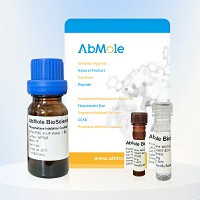All AbMole products are for research use only, cannot be used for human consumption.

GSK-3 beta/GSK3B Protein is a serine-threonine kinase, belonging to the glycogen synthase kinase subfamily. GSK3B participates in the Wnt signaling pathway. It is implicated in the hormonal control of several regulatory proteins including glycogen synthase, MYB, and the transcription factor JUN. GSK3B also plays an important role in ERBB2-dependent stabilization of microtubules at the cell cortex. It prevents the phosphorylation of APC and CLASP2, allowing its association with the cell membrane. GSK3B phosphorylates MACF1 and this phosphorylation inhibits the binding of MACF1 to microtubules which are critical for its role in bulge stem cell migration and skin wound repair.
The recombinant mouse GSK3B consists of 439 amino acids and has a calculated molecular mass of 49 kDa. It expressed the target gene encoding the mouse GSK3B (Met 1-Thr 420) with a polyhistidine tag at the N-terminus.
Immobilized His-mGSK3B at 10 μg/ml (100 μl/well) can bind biotinylated human HG3C-CTNNB1, EC50 of biotinylated human HG3C-CTNNB1 is 0.15-0.35 μg/ml.
Endotoxin < 1 EU/µg
Apparent Molecular Weight: 47 kDa, reducing conditions
Supplied as sterile 20mM Tris, 500mM NaCl, 25% glycerol, 0.2mM DTT, pH 7.4.
Shipping with dry ice.
| Form | Solution |
| Storage | Stable for up to twelve months from date of receipt at -20℃ to -80℃. |
| Related Cytokines and Growth Factors Products |
|---|
| Recombinant Human GDF-15 Protein (HEK293 N-hFc)
Growth-differentiation factor 15 (GDF15), also known as MIC-1, is a secreted member of the transforming growth factor (TGF)-β superfamily. GDF-15 has a role in regulating inflammatory and apoptotic pathways in injured tissues and during disease processes. GDF-15 overexpression arising from an expanded erythroid compartment contributes to iron overload in thalassemia syndromes by inhibiting hepcidin expression. |
| Recombinant Human FGFR1 Protein (HEK293, C-His)
FGFR1, also known as CD331, is a full-length representative protein consists of an extracellular region, composed of three immunoglobulin-like domains, a single hydrophobic membrane-spanning segment and a cytoplasmic tyrosine kinase domain. |
| Recombinant Human FGFR2 Protein (HEK293, C-His)
FGFR2, also known as CD332, acts as cell-surface receptor for fibroblast growth factors and plays an essential role in the regulation of cell proliferation, differentiation, migration and apoptosis, and in the regulation of embryonic development. FGFR2 plays an essential role in the regulation of osteoblast differentiation, proliferation and apoptosis, and is required for normal skeleton development. It also promotes cell proliferation in keratinocytes and imature osteoblasts, but promotes apoptosis in differentiated osteoblasts. |
| Recombinant Mouse BMP-4 Protein (E. coli, C-His)
Bone Morphogenetic Protein-4 (BMP-4) is a critical signaling molecule required for the early differentiation of the embryo and establishing of a dorsal-ventral axis. BMP-4 is secreted from the dorsal portion of the notochord, and it acts in concert with sonic hedgehog to establish a dorsal-ventral axis for the differentiation of later structures. |
| Recombinant Human Coagulation Factor X (HEK293, C-Fc)
Coagulation factor X, belongs to the peptidase S1 family. Coagulation factor X is initially synthesized in the liver. Coagulation factor X is a vitamin K-dependent glycoprotein that converts prothrombin to thrombin in the presence of factor Va, calcium and phospholipid during blood clotting. |
All AbMole products are for research use only, cannot be used for human consumption or veterinary use. We do not provide products or services to individuals. Please comply with the intended use and do not use AbMole products for any other purpose.


Products are for research use only. Not for human use. We do not sell to patients.
© Copyright 2010-2024 AbMole BioScience. All Rights Reserved.
